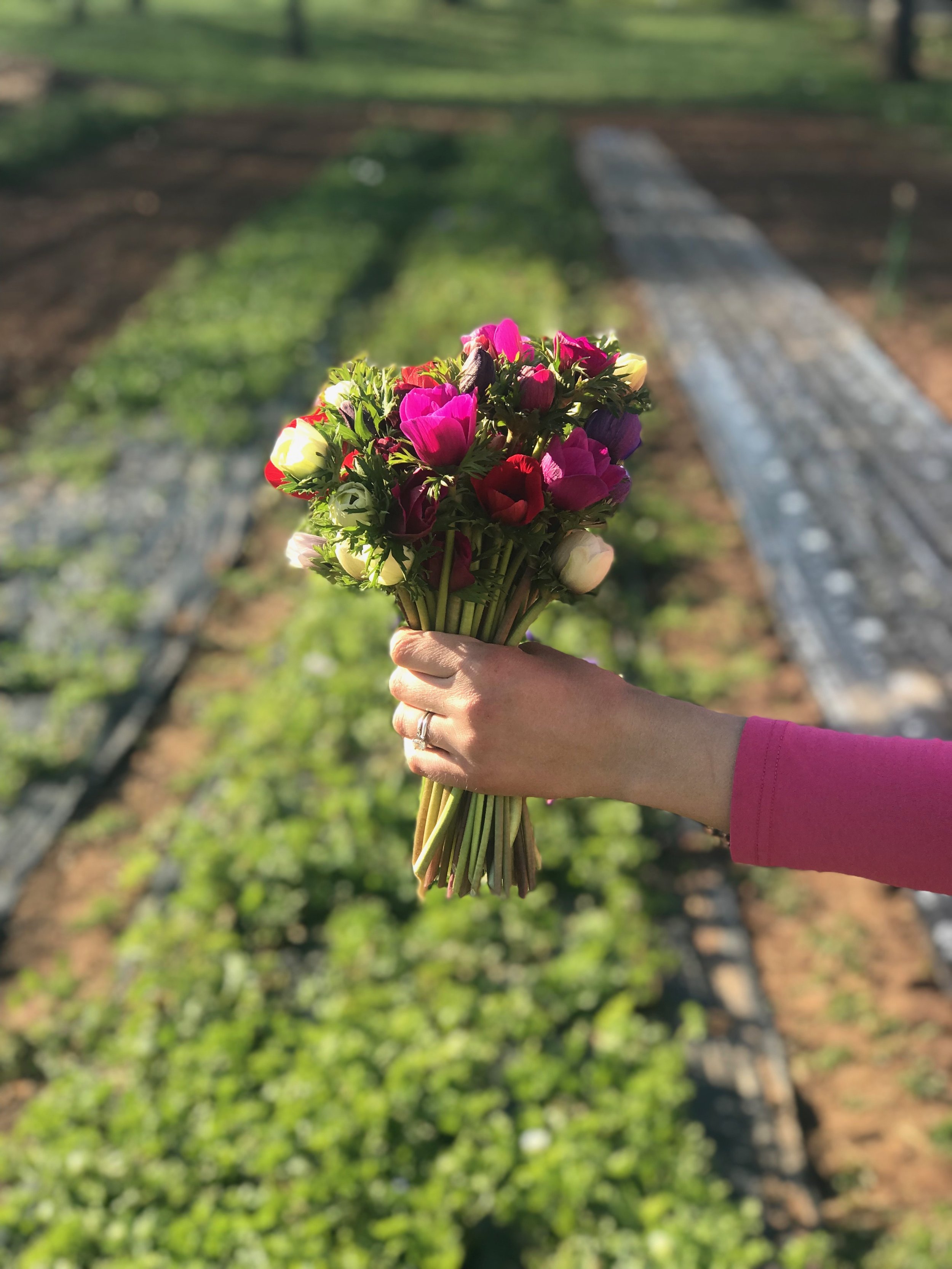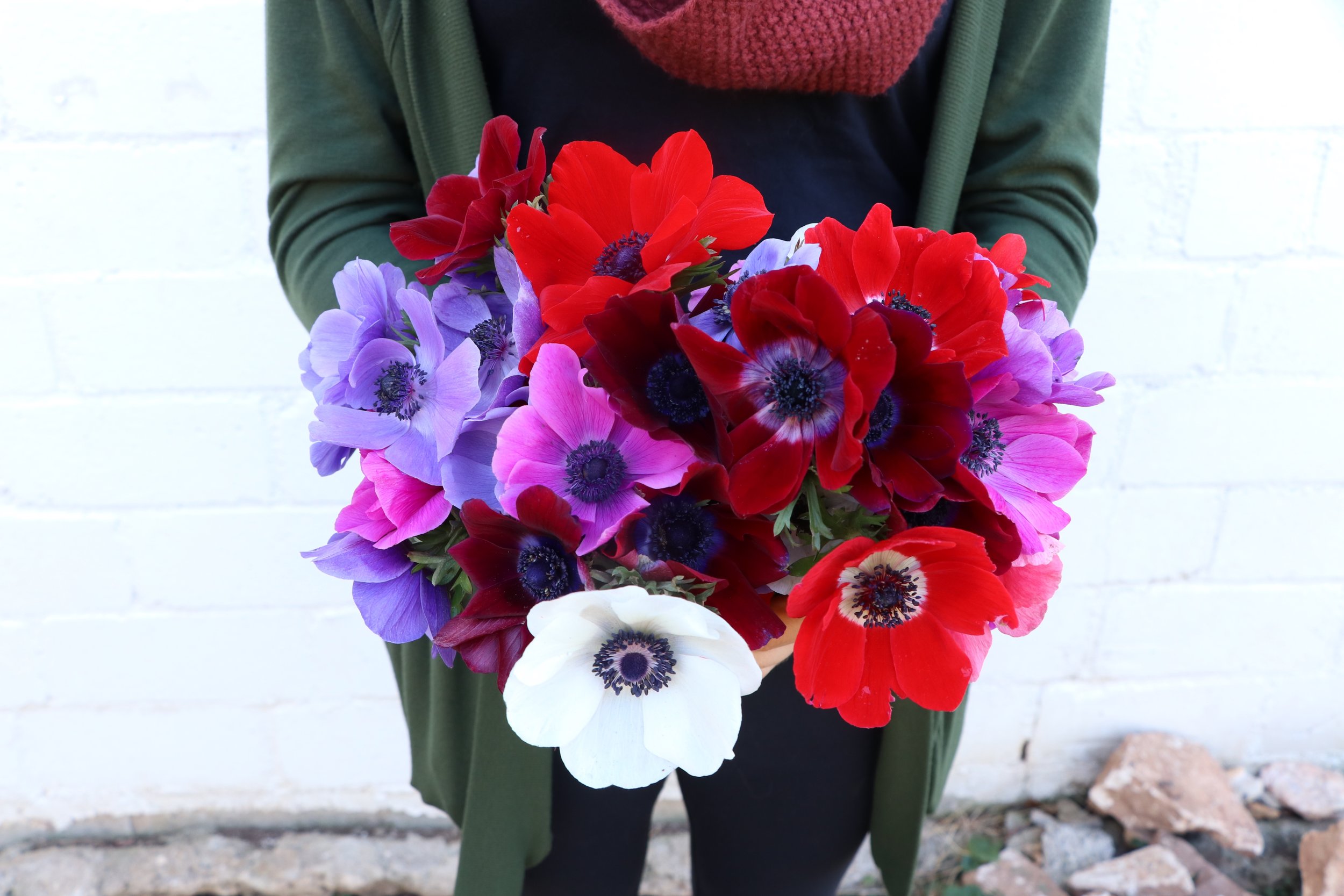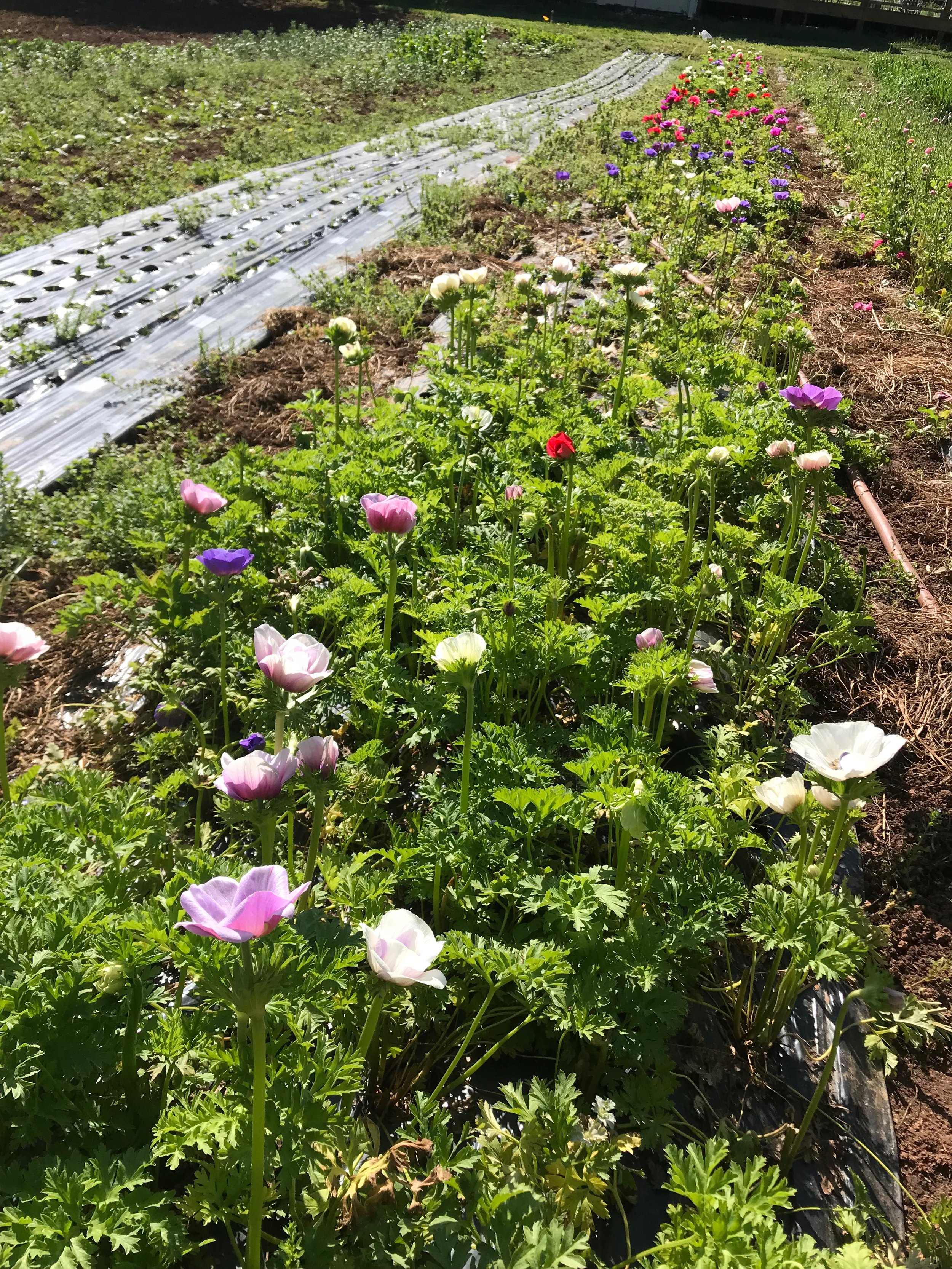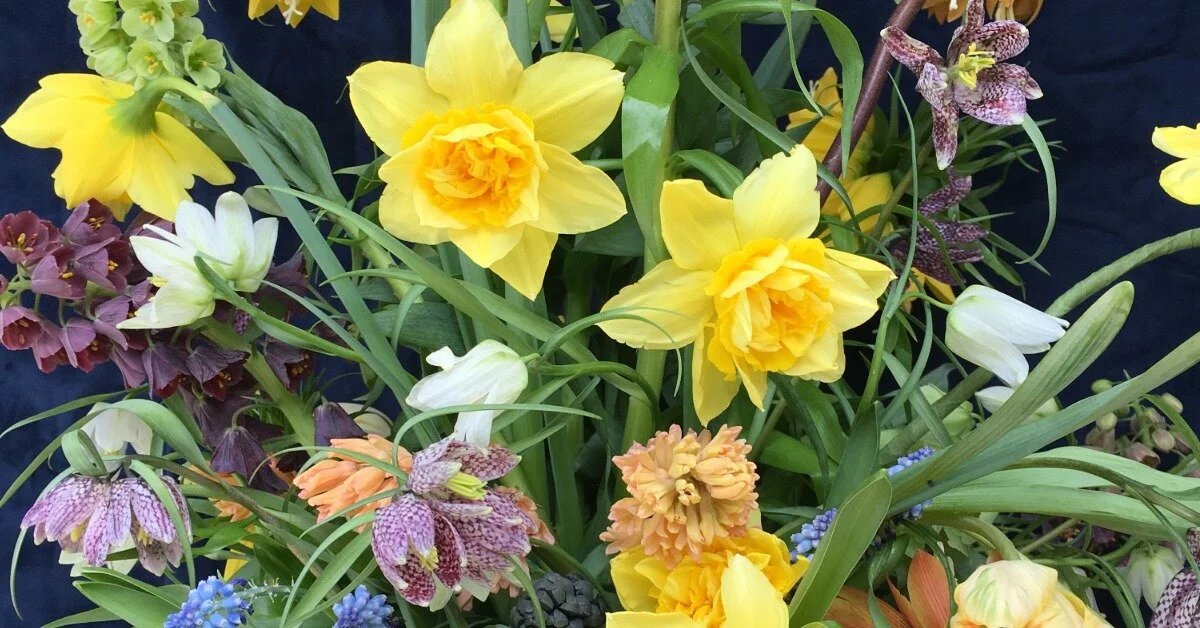How to Grow Anemone Flowers: A Quick (Yet Comprehensive) Guide
Anemones flowers are one of the toughest, most productive, earliest-blooming, and longest-lasting flowers that you could grow. We love to grow on our farm in the Charlotte, North Carolina, area. This crop is a fantastic addition to even the smallest of cutting gardens. These beautiful blooms require a bit of knowledge and work to grow effectively, but the rewards are more than worth the effort.
For quick tips growing anemones and how to care for them, follow along with this article! I’ll be covering the following, but feel free to jump to the section that you need today:
Sourcing Anemone Bulbs
If you’re looking for anemone bulbs, one of the first things you might discover is that anemones grow from corms, these little things that look like acorns that are solid stem bases of the plant. However, many refer to them as “anemone bulbs,” and if you’re searching the internet for supplies, that phrase may yield better search results.
Hi there! Love flowers? Us too! If this is your first time learning with us, discover more about how we can help you on your journey with flowers here.
Large Wholesale Suppliers Anemone Corms for Flower Farms
If you’re a flower farmer looking for wholesale suppliers for anemone bulbs/corms, I recommend suppliers such as Gloeckner or Onings. Typical minimum orders are 100–250 anemone corms per color or type.
Smaller Suppliers of Anemone Bulbs for Cutting Gardens and Micro Farms
If you’re looking to order on a smaller scale, perhaps for your small cutting garden, microfarm, or home flower bed, I suggest Floret Flowers and Renfrow Farms. You’ll receive 10–20 corms per package.
You can occasionally find anemone flowers at big box stores, garden centers, or other online retailers, but these are often not the varieties best suited for cut flowers, in my opinion. The stems are shorter, and they are usually available only in a mix of colors. If you are planning to grow the blooms to sell, check out the wholesale suppliers I recommended.
When to Place Your Anemone Corm Orders
Wholesale orders should be placed in the spring and summer for delivery in fall and winter. Shipping typically begins in September so there is ample time to pre-sprout your crop (see below).
Anemone Flower Colors and Varieties
There are many anemone flower varieties to choose from. They also come in a wide range of vibrant colors, listed below:
Purple
Blue
Pink
Red
Burgundy
White with green centers
White with dark centers (the popular “panda anemone” type)
A few different bicolors
Pastel pinks
Purplish shades
I recommend the following anemone flower varieties when growing for cut flower work:
Jerusalem
Galilee
Meron
Carmel
Marianne
Anemone bulbs (or Corms)
How to Pre-Sprout Anemone Flowers
Remember: Anemones grow from those little corms. Soak your corms for several hours in a full bucket of cool water to hydrate and plump them up, keeping the water dripping and water overflowing so that oxygen is continuously added.
Anemone Corm Roots
For optimal results, pack the corms in damp vermiculite and store at around 35 degrees Fahrenheit for several weeks (up to a month), checking periodically. When roots at least ¼” long emerge like in the photo below, they are ready to be planted. Toss any diseased or moldy corms.
Alternatively, try potting anemone bulbs or corms into small pots or cell packs and after cooling pull them out and let sprout in sunlight before transplanting, keeping well-watered.
Keep in mind that dry weather is not optimal for setting out pre-sprouted anemone flowers and ranunculuses. They could dry out before sprouting above ground and result in some crop losses.
Learn how to grow flowers for market and floral design in our Foundations for Growing Cut Flowers online class. Get lifetime access to complete growing lists, comprehensive video instruction and notes, and so, so much more!
A Note for Hobby Gardeners and Micro Farmers
If you are a hobby gardener without a flower cooler, try planting your anemone corms in small pots or cell packs after soaking, keeping them moist and storing them in a shady and cool spot until you see them sprout. Once sprouted, plant in the garden.
Planting and Growing Anemone Flowers
In warmer climates, plant anemone flowers out in the fall (usually October and November). I also put out another batch in December and/or early January.
In colder northern climates, they won’t survive the winter, so you will need to wait and plant out in mid to late winter. Water them very heavily when first planted or plan on planting them out before a very heavy rain.
Anemone Watering Tips
While anemones depend on a consistent water supply to grow well, they also don’t like overwatering or wet feet, so do not plant them in a low-lying spot with poor drainage.
Fertilizing Anemone Flowers
As for fertilization, backyard gardeners can use the same organic garden fertilizer they use on other flowers and vegetables at planting (like Espoma Organic Plant-Tone or Garden-Tone). Fertilize again once or twice during the growing season. For farmers, your corm supplier should provide you with detailed fertilizer recommendations.
Setup and Weed-Control Notes for Growing Anemones
Anemones can successfully be grown in pots or raised beds. Regardless of where you plant them, space each corm approximately 9” apart. I space mine 12” apart between rows and 9” apart within the row, with four rows per 4” wide bed.
Anemones can handle a variety of weeding methods, from landscape fabric or plastic to leaf mulch or hand-weeding.
Wintertime Protection for Anemones Grown in the South
High tunnel, low tunnels, row covers, oh my!
Cover anemones during cold spells
Recently on my farm in North Carolina, we had a very cold winter, and I covered my plants with a heavy row cover for the coldest week or two—but otherwise, I left them uncovered and they still produced abundant, tall stems this spring.
Protection through cold spells will enhance stem length, plant quality, and bloom quantity, but I’ve found that anemones are remarkably resilient and small-scale growers in my climate can be successful without the additional infrastructure of a tunnel with plastic.
“Protection through cold spells will enhance stem length, plant quality, and bloom quantity, but anemones are remarkably resilient.”
Harvesting Anemone Flowers for Cut Flower Work
To harvest anemone flowers for the most extended vase life, collect flowers when the bloom has grown to be about ¼” above the little “collar” leaf on the stem beneath it.
If you harvest blooms earlier, the blooms will be smaller but last longer; harvest later, and the blooms will not last as long in the vase, but they will be larger and still potentially able to be used in short-term designs for weddings and other events.
The stem length will be very short at the beginning of the season, but then will stretch to 12–18” if you keep harvesting them.
Harvesting Tool Sanitation
Always practice good sanitation for extended vase life. Sanitize your clippers/shears, use clean water, and change the water of held blooms every other day and give the held stems a fresh cut. These conditions will typically provide at least a week of vase life.
Weather and Harvesting Plans
Rainy and/or cold weather will cause splotches and browning on the petals (especially on white and pastel varieties), so prioritize harvesting anemones before a storm or cold night if either are in the forecast and you need them!
Cut Flower Storage for Anemone Blooms
Store upright to keep stems from bending. Blooms can be stored in a cold floral cooler for several days without impact on vase life.
Harvest Season for Anemone flowers
Anemones are ready for harvest in winter and early spring in the Southern U.S. as well as spring in Northern U.S. climates.
My plants start blooming by late February (North Carolina Zone 7B/8A)—and even earlier in a mild winter.
They can begin blooming even earlier than that in unheated high tunnels or low tunnels or in a heated greenhouse space.
Regarding field-grown, minimally-protected anemones in zone 7b/8a, the season can often run from mid-late February through late April—with a bit of leeway on either end depending on how warm or cold our winter and spring temperatures are each year.
A Note on Low Growing Tunnels:
I focus almost exclusively on field-growing crops and have only dabbled in experimentation with low tunnels, which is a short, unheated greenhouse-type structure over one row of plants in the field that provides a few degrees of protection in the coldest temperatures.
My family also owns and operates a 120-year-old “mom-and-pop style” hardware store in historic downtown Matthews, North Carolina—and the biggest part of our business is gardening, which makes me prioritize being at our store most days in the late winter and spring.
Because I am not up at our farm full-time, I personally tend to not utilize tunnels with greenhouse plastic because I am unable to continuously “vent” them on days when they heat up in the sunshine.
Anemones do not like temperatures that climb above the mid-sixties, and the temperature in a closed plastic covering structure can quickly surpass that on a cold but sunny day without proper ventilation.
If you are a casual backyard gardener or very new grower in a warm climate like mine, I recommend growing them for the first time with no more protection than an occasional row cover blanket during cold snaps below around 28–30 degrees. Anemones are low-maintenance and more forgiving of occasional neglect than many other flowers—which is another reason I love them so much!
“Anemones are low-maintenance and more forgiving of occasional neglect than many other flowers.”
anemone flowers growing in a row
Saving Anemone Bulbs (AKA Anemone Corms)
At the end of the season when the corms are about to go dormant, which is triggered by temperatures climbing in the 70s and above, I let my flowers fully bloom open for a few days without harvesting.
I do this so that as I dig up the corms, I can be 100% certain about what color each corm is and sort any that got mixed up in planting or arrived mislabeled.
I let the anemone corms dry out for a few days in the heat before cutting off all the foliage, bagging them up in mesh bags by color/variety, and storing them in a well-ventilated corner of our air-conditioned design studio workshop.
“Check your corms periodically so that if you notice any mold or disease, you can toss infected corms before they affect others. ”
Check your corms periodically so that if you notice any mold or disease, you can toss infected corms before they affect others. Then, you can start the growing season all over again with pre-sprouting them in September/October.
Anemones may also be perennial-ized in the field if you have space to leave them, just don’t forget where they are and don’t let the weeds completely take over! Over-summered dormant anemones will begin to pop up in the fall. The foliage looks a bit like curly parsley.
I hope that this information gives you the confidence to add this gorgeous flower to your garden next season!
For more floral design and growing tips, tricks, and videos, sign up for our industry-leading newsletter for flower-loving people. Over 35K flower pros and fans have joined!















